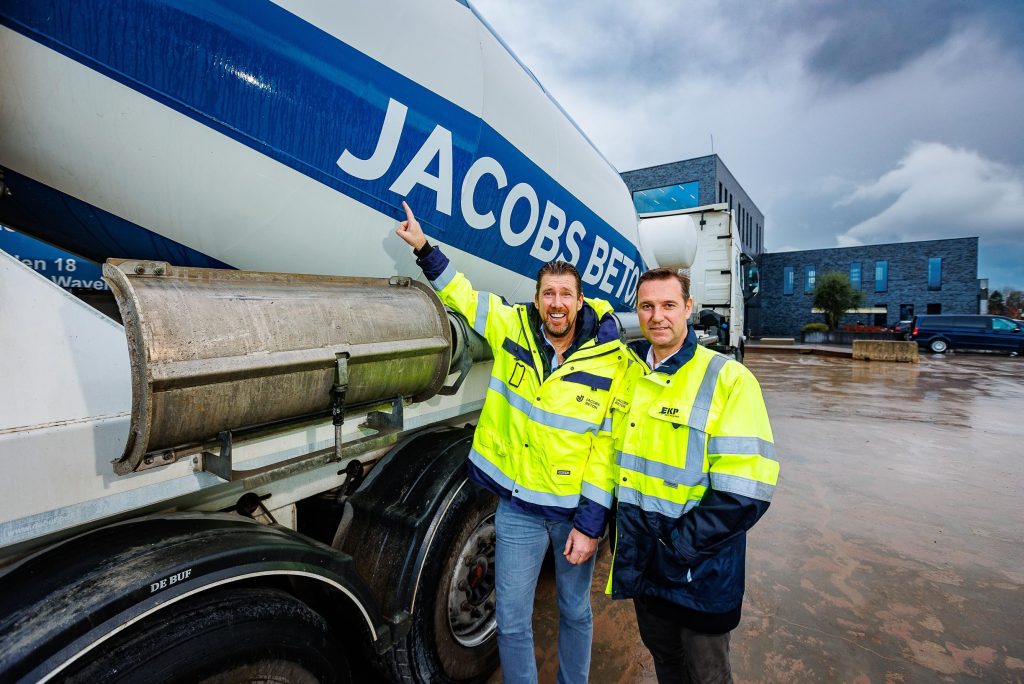Revive, the project developer behind Komet, has been advocating for several years to build Mechelen’s most sustainable residential area on the site of a former barrel plant. Heat pumps are used to heat 320 apartments and houses in the new town area of Koningin Astridlaan, without the use of fossil fuels. The developer will install more than 2,000 square meters of solar panels on the roof. The entire residential area will also be around 1.5 hectares of green space.

Brothers Eric and Kurt Jacobs create the first product in our country with recycled concrete on an industrial scale. – © Dirk Vertumen
“The time for promises is over”
Revive also sees potential in Jacobs Beaton’s circular production process. “At the recent climate conference in Glasgow there was again a lot of talk and a little bit of action. The time for promises is over, it is time for action,” says Alexander Huyge, CEO of Revive. “We place great importance on innovation, because that is how you make a difference,” he says.
The Flemish Building Consortium (VCB) emphasizes that this approach is innovative. “Using granules on such a large scale is innovative,” says General Manager Mark Dillin. The first phase of the Comet project, valid for 128 housing units, is scheduled to be ready by the end of 2022. Jacobs Beton provides about five thousand cubic meters of concrete from its concrete plants in Sint-Katelijne-Waver and Hemiksem.

The first circular concrete buildings in the Comet are under construction. – © Dirk Vertumen
The family business received the so-called Benor’s approval. As a result, our circular concrete is no longer tied to a specific project. Since we no longer have to test and approve concrete for every project, we can distribute it on an industrial scale,” says Kurt Jacobs (49).
Recycling of concrete rubble
With his brother Eric, 52, he runs the family business that has been around since 1934. “Ten years ago, we started investigating whether we could recycle the concrete rubble and reuse it in new concrete,” says Kurt Jacobs. In this way, the company can control the quality itself. “We are responsible for the recycling and production of concrete. A few years ago we discovered and adopted high-quality granules. Now we are turning that into concrete.”
Jacobs is pleased to have been able to collaborate with Revive, consultancy VK Architects & Engineers, and contractor Democo to develop their products. “All of these people were open to letting us run the tests on the concrete, because they wanted the project to be sustainable. We replace 30% of our natural granules with recycled granules,” Jacobs explains.

Impression of the new city district. The first phase will be completed at the end of 2022. – © Revival
The project partners call this a milestone that should not be underestimated. Material use in the construction sector is responsible for five to ten percent of global carbon dioxide emissions and at least 30 percent of a mountain of waste. “We can finally do something about it, without sacrificing the quality and strength of the concrete,” says Alexandre Huyghe of Revive.
“It doesn’t stop here.”
In the residential area, the first buildings made of recycled concrete are still under construction: in foundations, walls, beams and floor slabs. “There are still some limitations, but that’s for the future. It doesn’t stop here, but the first step has been taken,” says Kurt Jacobs.
For the construction of Komet, 1500 tons less of natural concrete pellets are needed. “This way we avoid having to drive 50 big trucks from the quarries in Wallonia to our yard,” explains Revive’s CEO. This equates to 7,500 kilometers of heavy transport. “This is good for carbon dioxide emissions and for our congested roads. We are also working to reduce demolitions and mountain waste in our country,” says Huegui.

“Coffee buff. Twitter fanatic. Tv practitioner. Social media advocate. Pop culture ninja.”











More Stories
Strong increase in gas export pipeline from Norway to Europe
George Louis Bouchez still puts Julie Tatton on the list.
Thai Air Force wants Swedish Gripen 39 fighter jets